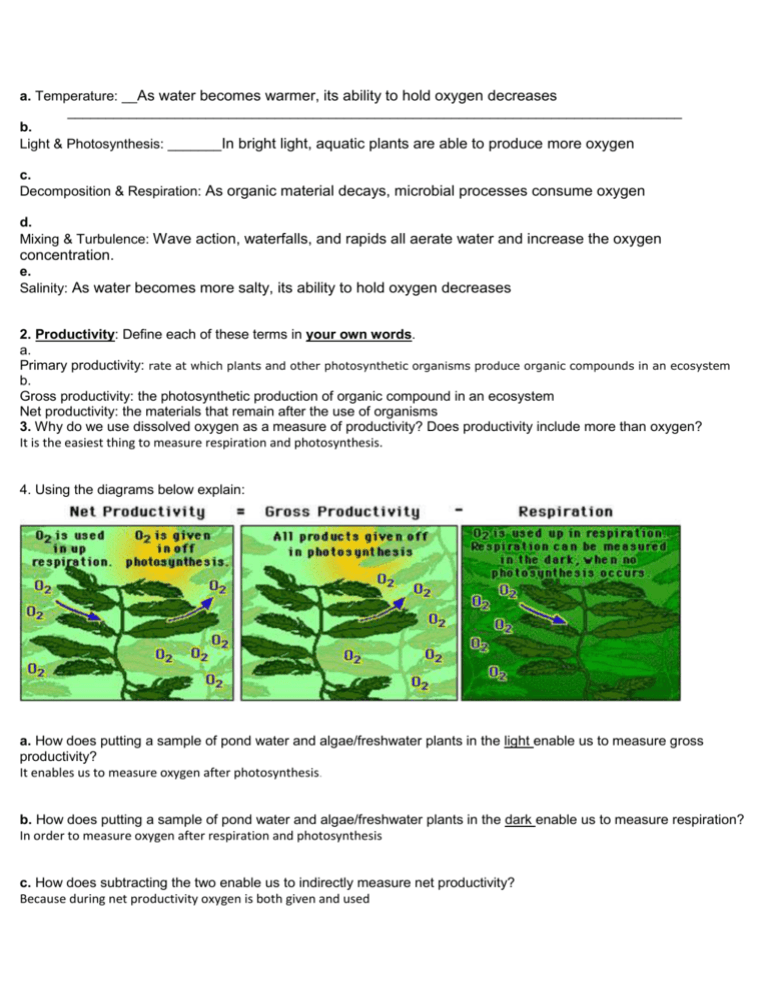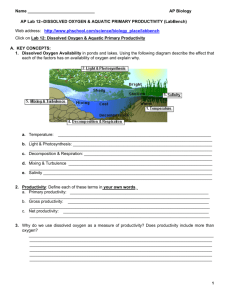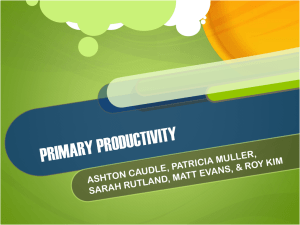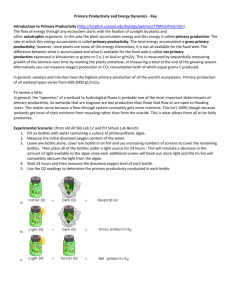File
advertisement

a. Temperature: __As water becomes warmer, its ability to hold oxygen decreases ________________________________________________________________________________ b. Light & Photosynthesis: _______In bright light, aquatic plants are able to produce more oxygen c. Decomposition & Respiration: As organic material decays, microbial processes consume oxygen d. Mixing & Turbulence: Wave action, waterfalls, and rapids all aerate water and increase the oxygen concentration. e. Salinity: As water becomes more salty, its ability to hold oxygen decreases 2. Productivity: Define each of these terms in your own words. a. Primary productivity: rate at which plants and other photosynthetic organisms produce organic compounds in an ecosystem b. Gross productivity: the photosynthetic production of organic compound in an ecosystem Net productivity: the materials that remain after the use of organisms 3. Why do we use dissolved oxygen as a measure of productivity? Does productivity include more than oxygen? It is the easiest thing to measure respiration and photosynthesis. 4. Using the diagrams below explain: a. How does putting a sample of pond water and algae/freshwater plants in the light enable us to measure gross productivity? It enables us to measure oxygen after photosynthesis. b. How does putting a sample of pond water and algae/freshwater plants in the dark enable us to measure respiration? In order to measure oxygen after respiration and photosynthesis c. How does subtracting the two enable us to indirectly measure net productivity? Because during net productivity oxygen is both given and used 5. What are the three ways that primary productivity can be measured? Highlight the way will be used in this lab?. a. amount of carbon dioxide used b. rate of sugar formation c. rate of oxygen production B. LAB PART 1: EFFECT OF TEMPERATURE ON DISSOLVED OXYGEN We actually did this part of the lab already. Remind yourself of our experiment, our procedures, and our conclusions. We were investigating the effect of the physical factor of temperature on the percent dissolved oxygen in a body of water. 1. What is the relationship between water temperature and dissolved oxygen? The lower the temperature the more dissolved oxygen it can hold 2. Explain why this relationship exists. Cold water molecules are compressed so they don’t move easily 3. So, now explain why the fish in the aquarium (on the LabBench Web site) above the radiator died? The water was warm which causes dissolved oxygen to decrease and the fish dies because it can’t get any oxygen c. A MODEL OF PRODUCTIVITY AS A FUNCTION OF DEPTH IN A LAKE 9. Why do we take an initial reading of dissolved oxygen? What purpose does this serve in the experiment? so that we can compare different changes 10. Click on the “closer look” magnifying glass on the “initial bottle”. Why does the animation show oxygen being diffusing out of the freshwater plants? What does this signify? plant is releasing oxygen through photosynthesis 11. Click on the “closer look” magnifying glass on the foil- covered bottle. Why does the animation show oxygen diffusing into the freshwater plants? What does this signify? It shows plants consuming oxygen which signifies respiration 12. Click on the “closer look” magnifying glass on the 100% bottle under the light. Why does the animation show oxygen diffusing both into and out of the freshwater plants? What does this signify? it shows both consuming and releasing of oxygen which signifies both photosynthesis and respiration are needed and sunlight is needed to complete the process. D. Analysis of Results 13. Measuring Respiration: Measuring Respiration: Remember that plants (producers) perform both photosynthesis and respiration. To measure the amount of respiration that is happening in the bottle, we measure the amount of dissolved oxygen in the initial sample and then the amount of oxygen in the bottle kept in the dark. As shown in the illustration below, you then subtract the amount of dissolved oxygen in the “dark bottle” from the amount of dissolved oxygen in the “initial bottle” to calculate the amount of oxygen consumed in respiration. I have added some possible measurements to help. Explain why this calculation works. The reason the calculation was effective was because it’s balanced during respiration and photosynthesis isn’t occurring. 14.Measuring Gross Productivity: Remember gross productivity is the total amount of sugars and oxygen produced by the plants in an ecosystem. I don’t like how this Web site shows you how to calculate gross productivity. The equation is correct, but it is a short cut, so it makes it more difficult to understand. So follow me with the illustrations and the possible measurements below. So the illustration shows us there was 10mg increase in dissolved oxygen in the jar as a result of photosynthesis in the last 24 hours and there was 5mg decrease in dissolved oxygen in the jar as a result of respiration in the last 24 hours. So the gross productivity (the full photosynthetic production in this ecosystem) of the algae in the bottle is the 5mg dissolved oxygen lost to respiration added back to the 10 mg dissolved oxygen accumulated in the bottle kept in the light. So what the algae really produced in the bottle was a total of 15mg dissolved oxygen, it just lost 5mg to respiration. And remember, the oxygen is an indirect measurement of the sugars produced in photosynthesis and lost in respiration. 10 mg oxygen gained from photosynthesis + 5 mg oxygen lost to respiration= 15 mg oxygen as gross productivity Now, in your own words, explain why this calculation works. The equation works because it’s the same equation as net productivity just switching of places. 15. Measuring Net Productivity: Remember net productivity is the amount of sugars and dissolved oxygen produced by the plants in an ecosystem once you subtract out what the producers have consumed in respiration. So we actually already calculated that in the last example; I just called it “net photosynthesis.” Explain why this calculation works. Because the equation indicated light do – initial do Print out the completed calculation table from Sample Problem page of the LabBench Web site, fill in your predictions on the graph as well, and attach it to this lab to show me that you have completed it. Print out the Lab Quiz and attach it to this lab to show me that you completed it. Would you expect the dissolved oxygen levels in water sampled from a stream entering a lake to be higher or lower than the dissolved oxygen levels in water sampled from the lake itself? Explain. I would expect water sampled from lake is higher than stream because it’s deeper and larger which is also able to have much phytoplankton. Would you expect the dissolved oxygen levels in water sampled from a lake at 7AM to be higher or lower than the dissolved oxygen levels in water sampled at 5PM? Explain. 7 am because phytoplankton can photosynthesize so more oxygen will be available. One of the major sources of water pollution is the runoff from fertilizer used in agriculture and on suburban lawns as well as golf courses. In particular, the nitrogen and phosphorus nutrients in the fertilizer create problems in the streams and ponds it flows into. They cause algal blooms and eutrophication in lakes. a. Why do nitrogen and phosphorus promote a lot of plant/algal growth? Nitrogen is needed for protein synthesis and phosphorus is part of energy flow b. What is meant by algal bloom? (Look it up!) Algae growth rapidly and in increased amount in aquatic habitat. c. What problems do algal blooms cause in ponds & lakes? Why isn’t a lot more producers a good thing? (Look it up! Their problem is that when they die they’ll release chemicals that will decrease in the ocean/ water body. d. What is meant by eutrophication? (Look it up!) Eutrophication is excess nutrients in a water body. At what depth—shallow or deep—will there be more primary productivity in a pond or a lake? Explain. In surface water there is lighter which means more primary productivity. In deep water there’s no light which the water is cold and makes it have less primary productivity. In an experiment, why do we use the mean of class data to make conclusions rather than individual student group data? Because there might different conclusions on each student so if we take the mean we will have a better result. 23. AP exam FRQ (2008). Consumers in aquatic ecosystems depend on producers for nutrition. a. Explain the difference between gross and net primary productivity. Gross includes all activity in terms of oxygen while net production is gross production due to respiration. b. Describe a method to determine net and gross primary productivity in a freshwater pond over a 24-hour period. Find the initial amount of oxygen and add the oxygen levels after photosynthesis and respiration. c. In an experiment, net primary productivity was measured, in the early spring, for water samples taken from different depths of a freshwater pond in a temperate deciduous forest. Explain the data presented by the graph, including a description of the relative rates of metabolic processes occurring at different depths of the pond. The lower the water the less primary production, includes the point when net is less than zero. Describe how the relationship between net primary productivity and depth would be expected to differ if new data were collected in mid-summer from the same pond. Explain your prediction. A change in graph or change in relationship between productivity and depth from spring to mid-summer graph.








